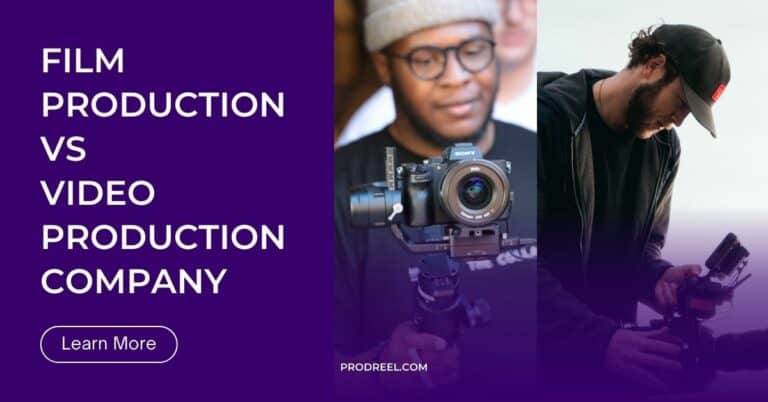Introduction
In the world of film and video production, transforming a creative vision into a captivating final product is a complex and multifaceted journey. This article delves into the five critical stages of film production, namely Development, Pre-production, Production, Post-production, and Distribution.
Each stage plays a significant role in shaping the film and ensuring its success.
Following are the stages of film production
The production process can vary depending on the scale and complexity of the project, but the following are the general stages and steps in a typical film production
1. Development
The Development stage involves idea generation, story selection, writing a treatment or outline, scriptwriting, and financing. This is where the foundation for a film project is laid and its creative direction established.
A strong concept and well-crafted screenplay are essential for a successful film. The Development stage ensures that the project starts with a compelling story, well-defined characters, and a clear vision. Securing financing during this stage is also crucial for a film’s feasibility and production quality.
Following are some of the things that happen in the development stage of a film or a movie –
Idea Generation
Brainstorming and researching ideas for the story or theme, including genre, tone, and target audience.
Story Selection
Choosing the most promising idea and refining it into a coherent narrative.
Treatment/Outline
Writing a summary of the story, detailing key events, characters, and settings.
Scriptwriting
Crafting the screenplay with dialogues, scenes, and actions based on the treatment or outline.
Financing
Securing funding for the project, whether through studio backing, investors, crowdfunding, or grants.
Some of the key questions to answer during the development stage are –
- What is the central theme or message of the film?
- Who is the target audience for this project?
- What is the estimated budget required for this film?
- How do we plan to secure financing for the project?
- Who will be involved in the scriptwriting process, and what is the expected timeline for completing the script?
2. Pre-production
Pre-production encompasses planning and preparation, including storyboarding, casting, location scouting, budgeting, crew hiring, scheduling, production design, and rehearsals.
Proper planning and preparation during pre-production are vital for a smooth and efficient production process. This stage helps the entire team understand their roles, sets realistic expectations, and allows for the allocation of resources, ultimately ensuring that the final product aligns with the original vision.
Following are some of the things that happen in the pre-production stage of a film or a movie –
Storyboarding
Creating visual representations of the script using illustrations or images to sequence the scenes. Check out some of the best Movie Stills websites we have listed to help you perfect your storyboard.
Casting
Auditioning and selecting actors for various roles in the film.
Location Scouting: Identifying and securing suitable locations for shooting, including obtaining necessary permits.
Budgeting
Preparing a budget that accounts for all expenses, such as equipment, crew, actors, and post-production costs.
Crew Hiring
Recruiting key crew members, such as the director, cinematographer, production designer, and sound designer.
Scheduling
Creating a shooting schedule, outlining when and where each scene will be shot.
Production Design
Developing the overall visual aesthetic, including sets, costumes, and props.
Rehearsals
Conducting rehearsals with actors to ensure they understand their characters and are comfortable with their performances.
Some of the key questions to answer during the pre-production stage are –
- Have we completed storyboarding and location scouting?
- Are all the necessary permits and permissions in place for shooting at the chosen locations?
- How does the casting process align with the characters and the overall vision of the film?
- Have we recruited all key crew members, such as the director, cinematographer, and production designer?
- Is the shooting schedule realistic and feasible, considering the budget and availability of resources?
3. Production
The Production stage is the actual filming of the project, involving set-up, filming, sound recording, maintaining continuity, and daily review.
Production is where the creative vision comes to life, and the story is captured on camera. This stage requires careful coordination, technical expertise, and efficient time management to ensure that the raw footage aligns with the project’s goals while adhering to the budget and schedule constraints.
Following are some of the things that happen in the production stage of a film or a movie –
Set-up
Preparing the shooting location with equipment, such as cameras, lights, and sound gear.
Filming
Capturing scenes according to the schedule, with multiple takes as needed to achieve the desired performance or camera angle.
Sound Recording
Recording on-set audio using boom microphones or lavalier microphones attached to actors.
Continuity
Ensuring consistency between shots and scenes in terms of props, costumes, and actors’ positions, often overseen by a script supervisor.
Daily Review
Assessing footage to ensure the director is satisfied with the shots and performances.
Some of the key questions to answer during the production stage are –
- How are we ensuring efficient time management and coordination on set?
- What contingency plans are in place for potential issues, such as weather-related disruptions or equipment malfunctions?
- How are we maintaining continuity between shots and scenes?
- What measures are being taken to ensure high-quality sound recording during production?
- How is the daily review process structured, and are any adjustments needed based on the footage obtained so far?
4. Post-production
Post-production consists of refining the raw footage and audio recordings into a polished final product. This stage includes editing, sound editing, music and sound effects, visual effects and color grading, titles and credits, and final review.
Post-production is essential for shaping the overall narrative, pacing, and emotional impact of the film. This stage brings together all the elements captured during production, enhancing and refining them to create a cohesive and engaging viewing experience for the audience.
Following are some of the things that happen in the post-production stage of a film or a movie –
Editing
Assembling the footage into a coherent sequence, often working closely with the director.
Sound Editing
Cleaning up audio recordings, removing unwanted noise, and adjusting levels for clarity.
Music and Sound Effects
Composing or selecting background music and adding sound effects as needed.
Visual Effects (VFX) and Color Grading
Creating any required visual effects and adjusting the colors and tones of the footage to achieve the desired look.
Titles and Credits
Adding text elements, such as opening titles and end credits.
Final Review
Reviewing the final edit with stakeholders and making any necessary changes before the film is completed.
Some of the key questions to answer during the post-production stage are –
- Are the editor and director working closely together to achieve the desired narrative and pacing?
- How are we approaching the sound design to enhance the film’s overall atmosphere and emotional impact?
- What visual effects or color grading techniques are being used to achieve the desired visual style?
- How are we addressing any feedback or issues identified during the final review process?
- What is the timeline for completing post-production work?
5. Distribution
Distribution is the process of releasing the completed film to the public through various channels, such as marketing and promotion, film festivals, sales and licensing, theatrical release, digital release, and physical release.
The success of a film largely depends on how well it reaches its target audience. The Distribution stage ensures that the film gains exposure, generates interest, and ultimately, recoups its investment and potentially achieves financial success. This stage is crucial for showcasing the work of the filmmakers and providing a platform for the film to be seen and appreciated by viewers.
Following are some of the things that happen in the distribution stage of a film or a movie –
Marketing and Promotion
Creating promotional materials, such as trailers, posters, and social media campaigns, to generate interest in the film.
Film Festivals
Submitting the film to festivals for potential awards and exposure.
Sales and Licensing
Negotiating deals with distributors, broadcasters, or streaming platforms to release the film.
Theatrical Release
Screening the film in theaters or other public venues.
Digital Release
Making the film available through online streaming platforms, on-demand services, or digital download.
Physical Release
Distributing the film on physical media, such as Blu-ray or DVD, for home viewing.
Some of the key questions to answer during the distribution stage are –
- What is the marketing and promotion strategy to generate interest in the film?
- Are we submitting the film to relevant film festivals for potential awards and exposure?
- What are the plans for negotiating deals with distributors, broadcasters, or streaming platforms?
- How are we ensuring the film reaches its target audience through theatrical and digital releases?
- Are there any plans for physical media releases, such as Blu-ray or DVD, for home viewing?
Most commonly faced issues during a film production
There are numerous things that can go wrong during a film production process, stemming from various factors such as human error, technical issues, or unforeseen circumstances. Some of the most common issues include:
1. Poor planning and organization
Insufficient preparation in the pre-production stage can lead to delays, budget overruns, and other problems during production and post-production.
2. Budget overruns
Mismanagement of funds, unexpected expenses, or changes in the scope of the project can lead to budget overruns, potentially impacting the final product’s quality or even causing the project to be abandoned.
3. Scheduling conflicts
Conflicting schedules of actors, crew members, or locations can cause delays and disruptions, which can be costly and detrimental to the project’s timeline.
4. Weather-related issues
Outdoor shoots can be significantly impacted by unexpected weather conditions, such as rain, snow, or high winds, causing delays and affecting the planned visuals.
5. Technical problems
Equipment malfunctions, such as camera, lighting, or sound gear, can lead to delays or even the loss of valuable footage.
6. Inconsistent performances
Actors may struggle with delivering consistent performances across multiple takes, causing the director and editor to spend more time trying to piece together a coherent sequence.
7. Continuity errors
Inconsistencies in elements such as costumes, props, or actor positioning can lead to noticeable errors in the final edit, potentially requiring reshoots or extensive post-production work to fix.
8. Poor communication and collaboration
Miscommunication or lack of collaboration among team members can result in confusion, errors, and an overall less cohesive final product.
9. Legal issues
Failure to secure the necessary permits, rights to music, or other legal aspects can result in costly delays or even potential lawsuits.
10. Post-production complications
Issues such as data loss, technical problems with software, or dissatisfaction with the edit can lead to extended post-production time, impacting the project’s deadline and budget.
Proper planning, communication, and risk management are essential to mitigate these potential problems and ensure a smooth production process.
Conclusion
The film and video production process is a collaborative endeavor that requires careful planning, execution, and refinement across various stages.
From the inception of a compelling story during the Development stage to the final release and exposure in the Distribution stage, each step plays a vital role in determining the success of a film project.
By understanding the nuances and challenges associated with each stage, filmmakers can better navigate the complexities of the production process, ultimately leading to a well-crafted and engaging film that resonates with its intended audience.
Frequently Asked Questions
The stages of film production are – Development, Pre-production, Production, Post-production, and Distribution.
Pre-production encompasses planning and preparation, including storyboarding, casting, location scouting, budgeting, crew hiring, scheduling, production design, and rehearsals.
Proper planning and preparation during pre-production are vital for a smooth and efficient production process. This stage helps the entire team understand their roles, sets realistic expectations, and allows for the allocation of resources, ultimately ensuring that the final product aligns with the original vision.
The Production stage is the actual filming of the project, involving set-up, filming, sound recording, maintaining continuity, and daily review.
Production is where the creative vision comes to life, and the story is captured on camera. This stage requires careful coordination, technical expertise, and efficient time management to ensure that the raw footage aligns with the project’s goals while adhering to the budget and schedule constraints.
Post-production consists of refining the raw footage and audio recordings into a polished final product. This stage includes editing, sound editing, music and sound effects, visual effects and color grading, titles and credits, and final review.
Post-production is essential for shaping the overall narrative, pacing, and emotional impact of the film. This stage brings together all the elements captured during production, enhancing and refining them to create a cohesive and engaging viewing experience for the audience.







